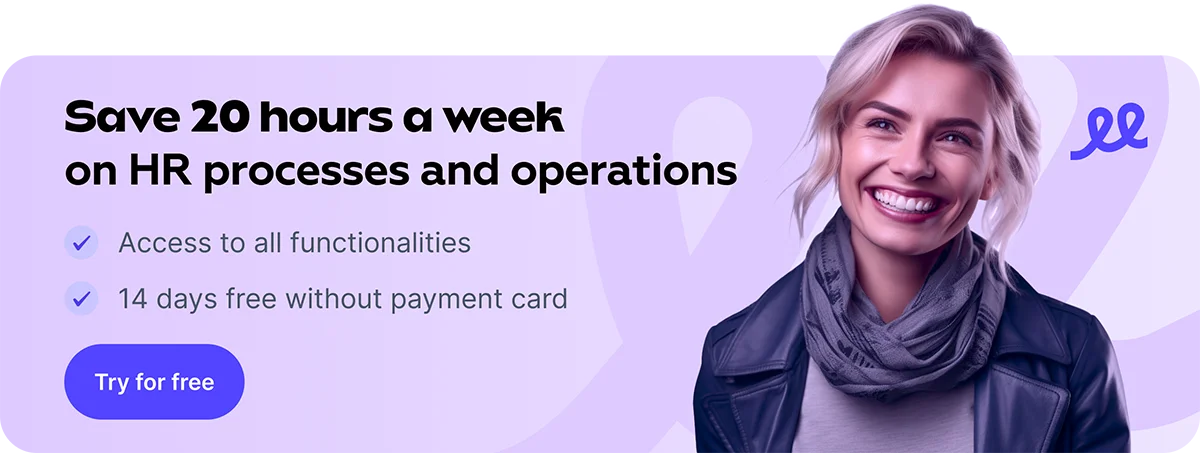5 sentences, after which the management is guaranteed to buy you an HR system

‚‚Boss, I can’t do it anymore…”
We know. As an HR manager, you don’t have it easy. The market isn’t exactly playing into your hands, but you need people. With the remote working, flexible hours, acquisition of company property for home office, changes, regulations, processes, GDPR and management who would like to have a good overview of everything on paper.
But with all the hustle and bustle and the agenda, the classic spreadsheets are not enough and you’re running out of breath. So you want to improve. A cloud‑based HRIS or human resources management system, maybe even an all‑in‑one HR software – a digital partner that handles everything from time and attendance management, absence management, payroll management and candidate management, to employee self‑service and learning management system modules…Modern HRIS systems (Human Resources Information Systems) are increasingly cloud-based, offering mobile apps and user-friendly interfaces. These platforms support HR teams by centralizing employee information and benefits administration, all accessible via employee self-service portals.
The first and biggest one is that management often doesn’t even want to hear about such conveniences – they see the unnecessary expense and start with an uncomfortable set of questions. Fortunately, we already know what those will be, so we’ll prepare you for them.
Tuck this article away out of their sight, because we’ll show you some charming tactics to get them on your side.
Just like an accountant needs a specialized tool, HR needs robust HRIS software or an internal human capital management system. With a core human capital management system – whether it’s cloud‑based HRIS, HR software focused on time and attendance management, absence management, payroll, performance management, talent management, candidate management, or learning management system – you can manage employee records, track attendance and assets, set up automated workflows, run performance management reviews, support employee engagement, and generate insightful people analytics with ease.
But what will you get out of it?
Save yourself and your managers time so you can all really focus on people
- You’ll be free of the same administration over and over again
- By automating your processes and workflows, you’ll speed things up and become a super HR pro, with your internal HRIS software optimizing every agenda step—from absence management to performance reviews and payroll.
- You’ll have order and peace of mind
- Compliance will praise you for bulletproof contracts, handovers, HSE, GDPR…
- Automation and custom workflows integrated into self-service portals give employees direct access to their data, reducing administrative burdens further
But these are still not arguments for the boss. So let’s tighten up. We’re going for 5 sentences guaranteed to convince management that you really need an HR system.
1. Sentence: ”It will save the company a lot of money”.
A minute here, a minute there and it adds up. Every wave of the hand with saying that this time, exceptionally (again) you fill it in manually, that it’s only a minute, costs the company time. And the more senior the position, the more expensive the time. As a result, without automation, it can take, say, xxx minutes per manager per month to do contracts, records, reports and attendance, which is already a hefty sum with ten managers. Accurate payroll processing and workforce management, including time tracking and overtime monitoring, save small businesses significant resources. Can’t you imagine? Do the math below.
2. Sentence: “We will keep an eye on everything”
What you sort of ”punk” out with a small company can already be quite a problem in a larger one, preventing it from taking off. And the company was founded by its owners to grow. To do that, you need to have an accurate picture of what your employee costs are, who has your company assets and why, who’s probation is ending, or maybe who got a recent raise. But a good HR system enriched by possible integrations also has task-based templates that simplify onboarding new colleagues and training, for example, so you’ll know exactly when it’s the right time to promote someone.
Comprehensive benefits administration and management tools, including health benefits and employee schedules, ensure smooth planning with software for holidays, shifts, and leave tracking.
3. Sentence: ”We will improve leadership”
What are paid managers for? To fill spreadsheets endlessly? That would be an expensive joke. A manager is supposed to focus on people, develop them, manage them, and thus promote the company’s vision and strategy. In the spirit of the first point, many reports can be automated, saving time and having more relaxed and focused management doing the work that really matters. Leveraging employee performance data, feedback, and predictive analytics enhances leadership’s ability to focus on learning, development, and succession planning, optimizing labor resources.
4. Sentence: ”The authorities won’t come after us”.
Without many people realising it, there are as many responsibilities, reports and entanglements in the company-employee relationship alone. What about such sensitive employee data? Do you know where it’s stored? And what if they leak? You don’t have to worry about this with an HR system. You set up who has access to what and you’re good to go. A good system will keep an eye on contracts and, in addition, directives, ensuring that it can be proven that the employee has actually read them. Even the most stringent controls. Modern HRIS provide legislative support, digital offer letters, background checks, and candidate screenings to maintain regulatory compliance and prepare detailed reports.
5. Sentence: ”The HR is not just doing paperwork anymore”.’
The days when HR people were mainly there to do administrative are over. Whether you look at Gartner data, a report from LinkedIn or the regular watching the LMC data breakfast, 2020 was a really big year for HR change. The digital overload, the move to home-office and the big wave of career changes has shown that without HR a business that is serious simply cannot function. HR is gradually moving into leadership roles, with the ultimate goal of extending the employee lifecycle. Not just in one role, but across the full breadth of an employee’s potential. In fact, turnover is haunting startups, corporates and mid-sized companies.
HR now utilizes applicant tracking systems, digital onboarding, and cloud-based document storage, supported by digital assistants and employee self-services portals such as Access PeopleHR to enhance the employee experience and compensation management.
So now you’re charged up and can slowly prepare your presentation.If your leadership suggests a free HR software or open‑source HRIS, remind them that even the best free tool usually doesn’t support full human capital management, talent management, employee engagement, performance management, payroll management or people analytics needed for a growing company.
So now you’re charged up and can slowly prepare your presentation. Below you will find handouts to help you prepare.
👉 How to choose an HR system? It must have these 7 things.
👉 9+1 of the most common problems that you can solve with a quality HR system




